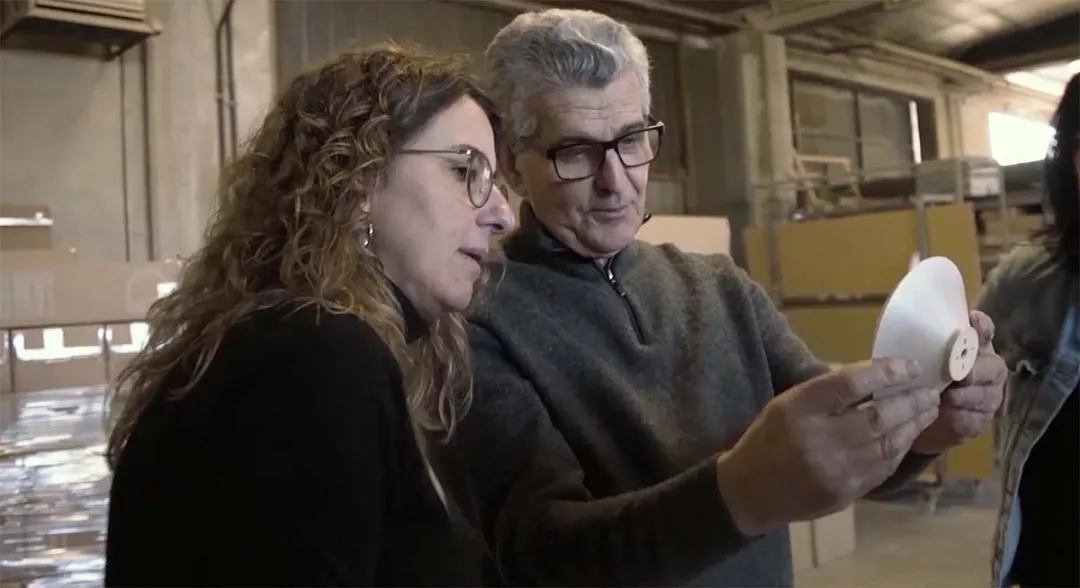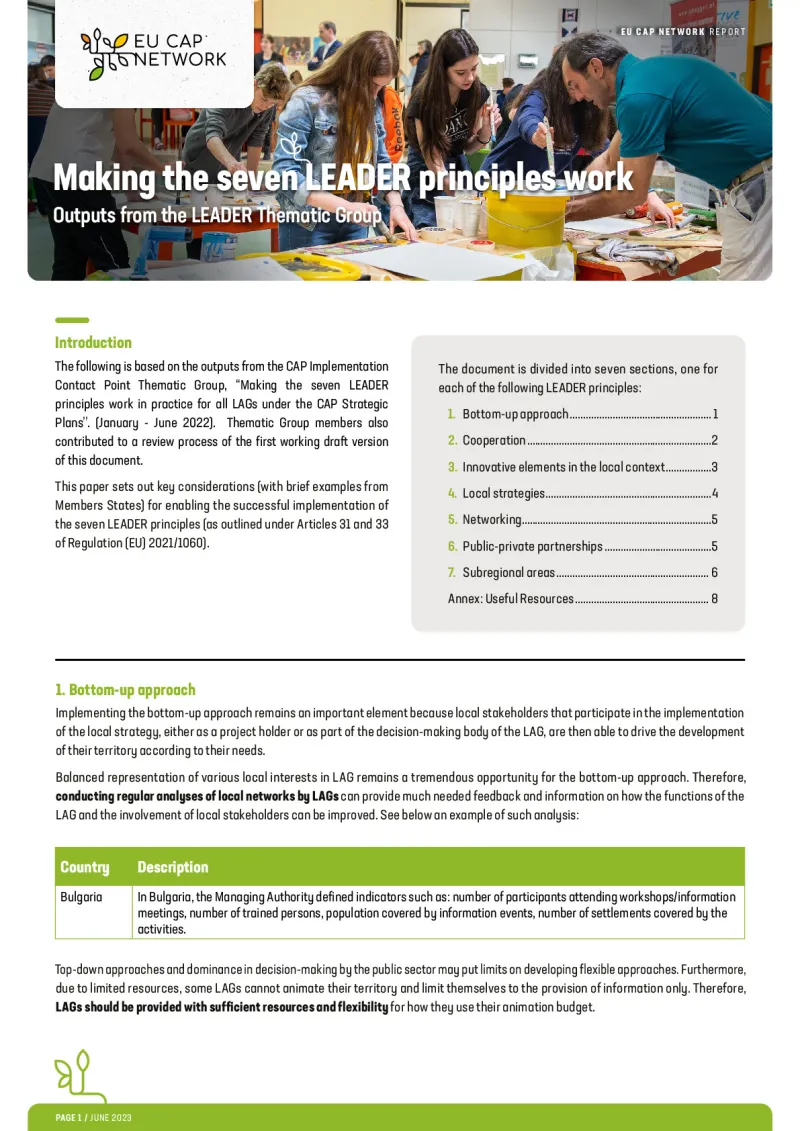LEADER Explained
Page contents
The LEADER Approach
This briefing explains the origins of the LEADER approach and its key characteristics (the 'seven features' of LEADER).
The name and the method
In the early 1990s, the LEADER approach was introduced as an experiment in response to the then perceived failure of traditional, top-down policies in addressing the problems faced by many of Europe’s rural areas. The name 'LEADER'' is an acronym derived from the French phrase "Liaison Entre Actions de Développement de l'Économie Rurale" which translated as '’Links between activities (or actions) for the development of rural economy''. The core idea was to unlock the energy and resources of local people and organisations from across the public, private and civil sectors by enabling and empowering them to shape the development of their locale, through partnership working in the form of Local Action Groups (LAGs).
The LAG partnerships are the main tool in the application of the LEADER approach, involving local representatives, leading the development and implementation of local strategies and in decision-making and resource allocation.
Brief history
The first generation of LEADER was introduced as an EU Community Initiative, i.e. a special financial instrument of the overall EU structural policy and aimed at finding new solutions to specific problems affecting the whole EU. In its experimental phase between 1991-1993, LEADER involved 217 areas in designated disadvantaged rural regions and could use multiple EU funds. Its focus on rural disadvantage continued under LEADER II between 1994-1999 when the number of LAGs increased to around 900. The encouraging results of this then led to approach being further expanded under LEADER+ (2000 – 2006) to cover all types of rural areas and applying a ‘thematic’ element to local strategies.
The approach was 'mainstreamed' in its fourth programming period (2007-2013) where it formed an integral part of the EU's rural development policy, covering 2 416 rural territories across all the Member States. It was funded by the European Agricultural Fund for Rural Development (EAFRD) and a mandatory component of all Rural Development Programmes. In 2007, the method was also extended thematically to include fisheries policy with over 300 Fisheries Local Action Groups (FLAGs) being developed in 21 Member States. This included direct links between coastal rural areas and a number of LEADER LAGs.

For the 2014-2020 funding period, the applicability of the LEADER approach was further extended as Community-Led Local Development (CLLD) in rural, fisheries and urban areas. CLLD could be applied under the EAFRD (as LEADER), the European Maritime and Fisheries Fund (EMFF), the European Social Fund (ESF) and under the European Regional Development Fund (ERDF). Where Member State programming permitted, LAGs could also prepare and deliver integrated strategies using multiple funds. Despite the multi-funding opportunities offered, LEADER LAGs and their rural remit have remained the main exponents of the LEADER approach.
As of 2024, the latest generation of LEADER continues to address the challenges and seize the opportunities in rural areas within the new framework of the 27 Member States and their CAP Strategic Plans (CSPs).
As LEADER has developed, so too have the mechanisms to support the approach; formal networking structures emerged early in its evolution, reflecting its partnership and territorial focus. From its early days as the original LEADER observatory, LEADER networking continued to evolve in the 2014-2020 period, providing technical support and other networking services for LAGs through National Rural Networks and the European Network for Rural Development. LEADER networking support is currently available through the EU CAP Network and the CSP-related National Networks across all 27 Member States.
The seven features of LEADER
The LEADER approach is based on seven specific features with its success dependent on all of these features being present and used together. These seven features define LEADER as a methodology, making it distinct from traditional funding programmes.

1. Bottom-up approach
The bottom-up approach lies at the heart of the LEADER approach, where local people are the best experts to drive the development of their own territory. Using a bottom-up approach means that local communities and other local players can define and determine a development pathway for their area consistent with and appropriate to their needs, expectations and plans. Using a collective (or partnership) approach with delegated decision-making responsibilities enables them to take charge of their area’s future. They make decisions about the local strategy and the selection of the priorities to be pursued. Active, fair and transparent participation is encouraged at every stage throughout the process of establishing the partnership and strategy development, implementation and review.
EU regulations enshrine the bottom-up approach, with provisions for animation and decision making to ensure that no one interest group can influence the implementation of LEADER disproportionately.
2. Area-based approach
LEADER (and CLLD) is based on a different way of doing things. The area forms the basis for the development of the local partnership and strategy by linking within a single approach and creating a positive vision for what could be taken further by an active partnership of local stakeholders. Under the 'Area-based approach' LEADER funding is allocated to target the (strategic) priorities of the area rather than specific projects or groups of projects.
Each LEADER area normally involves a small, socially and functionally cohesive and clearly defined or homogenous territory. Such areas may be characterised by common traditions, a local identity, a sense of belonging or common needs and expectations. The area chosen by the partners must also show sufficient coherence and critical mass in terms of its human, financial and economic resources to support a viable local development strategy.
Having a common area-based focus enables the local partnership to work together to identify and address local strengths, challenges and opportunities, mobilising the area's own endogenous potential and resources.
3. The local partnership
LEADER local partnerships for area development are organised around a specific and structured governance mechanism – known as the Local Action Group (or LAG). Direct involvement in such a partnership means that people become active partners and drivers of their area's development in their own right; this is a defining characteristic of the LEADER approach.
All LAG partnerships are unique, no two partnerships are the same in their origin or development. Partnerships are also dynamic, taking time, effort and commitment to build trust to meet the needs and realities of their local context.
A LAG should comprise partners from public, private and civil society; it should be well-balanced and broadly representative of local interests and the different socio-economic sectors in the area. No single interest group can control the decision-making within the local partnership.
While a LAG's legal form may vary from country to country, it is often a non-profit, registered organisation. Regardless of their legal form, LAGs may nominate a suitable partner to act as their formal accountable body. In many cases, this will be an organisation with sufficient capacity to support the LAG’s operation.
4. An integrated and multi-sectoral strategy
The development and delivery of integrated and multi-sectoral area based local development strategies (LDSs) continues to be a feature of LEADER, with LAG partnerships and their LDSs looking to capitalise on the links between local sectors to exploit the potential multiplier effects to add value.
In preparing their LDS the LAG explores and addresses the area’s needs and opportunities in an integrated way. In this way, it is helping to achieve the desired common goals, with actions and projects clearly connected and coordinated as a coherent whole. Integrated does not mean all-encompassing, as some things will lie beyond the local scope or ability to influence or deliver. LAGs, in preparing their LDSs, make choices and focus on those objectives and actions that add value and have the greatest chances of contributing to achieving the changes they want.

5. Networking
Networking is critical to implementing the LEADER approach. The LAG is a network of local partners and through its strategy and activities, it promotes links between local actors and others in the development chain and area.
Networking enables all those involved to promote inclusion, build capacity and strengthen capabilities, providing the critical mass for those involved to share their knowledge, experience, innovations and ideas.
The benefits of networking in LEADER extend well beyond the immediate locale with LEADER networks extending regionally, nationally and internationally to stimulate and support cooperation between LAGs.
The advent of an EU CAP Network and Member State National Networks in this programming period, alongside an EU level Subgroup on LEADER and Territorial Development is contributing to the continuity of networking support for LEADER.
LAG-led networking organisations have also emerged to support exchanges between LAGs. These include the European LEADER Association for Rural Development (ELARD) and LEADER Inspired Network Community (LINC).
6. Innovation
The quest for innovation has been a key principle of LEADER from the outset and remains one of the most exciting, ground-breaking and yet challenging parts of the whole approach. The LAG concentrates on seeking out and fostering new and innovative solutions to local problems with local people or on identifying and taking advantage of the opportunities or challenges presented. Innovation applies to what is done, the types of activity supported, the products or services developed etc. but importantly it also applies to how things are done and how local people are involved.
Each LAG should aim to be creative and bring new elements and solutions to the development of its territory and work of the partnership. This applies in its strategy and its implementation, particularly approaches to animation, decision making and project selection. Innovation will invariably involve a degree of acceptable risk, however by creating the right conditions and by carefully cultivating new and fresh ideas, LAGs can produce substantial and sustained changes and benefits for their territories, in many respects the real added value which LEADER is designed to achieve.
7. Cooperation
Interterritorial and Transnational Cooperation (TNC) add a wider dimension to local development in rural areas and has been supported through successive networking structures. Co-operation goes further than networking by involving local people and LAGs in working with others to undertake a joint project. This can involve other LEADER groups or a similarly formed group in another region, Member State or non-EU country. Cooperation actions may also involve other European Funds.
Cooperation actions should have a clear purpose and benefits that flow from working with others. Cooperation with other regions can be an excellent source of innovation and knowledge transfer for local people. LEADER cooperation enables the introduction of new perspectives or insights on successful approaches and on good practices from other areas.
Whilst the benefits of cooperation can be considerable, it is important to plan carefully, (e.g. choose the right topics, partners etc.) and to take advantage of support offered through National Networks and the EU CAP Network.
